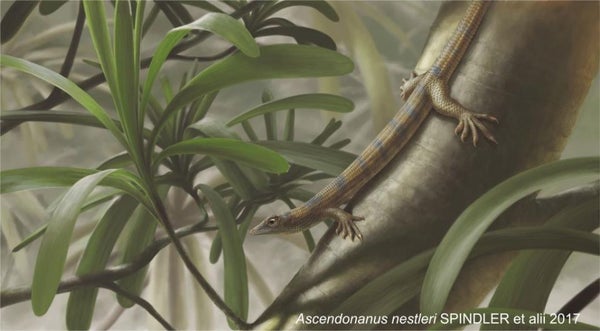This article was published in Scientific American’s former blog network and reflects the views of the author, not necessarily those of Scientific American
What did our protomammal ancestors and relatives look like when they were scampering around the Permian world? That's been an extremely difficult question to answer. The tradition, held since the time we used to call them "mammal-like reptiles", has been to go for a more saurian pastiche. The likes of Dimetrodon have often depicted as scaly, befitting their belly-dragging, sprawled posture, with only cynodonts and similar synapsids (that is, members of the wider group from which mammals sprung) getting roughly more mammalian treatments given their proximity to the emergence of the first beasts.
But paleoart keeps pushing the envelope. It's not uncommon to see fuzzier depictions of Dimetrodon these days, or gorgonopsids that look like strange dogs. The fossil record leaves little resolution. The bones of these animals tell us that they're closer to us than to reptiles, but the origin of fur and whiskers is confounded by a lack of fossilized soft tissues from the critical time period. That problem remains, but a new species of exceptionally-preserved protomammal from the 290 million year old rock of Germany adds a little more context to discussions of what early synapsids looked like.
Paleontologist Frederik Spindler have called the little creature Ascendonanus nestleri, several exceptional specimens revealing this synapsid in exceptional detail. The articulated skeletons show Ascendonanus to be lizard-like in overall form, Spindler and colleagues pointing to particular traits of the limbs and claws to suggest this protomammal spent most of its time in the trees. But what really got the attention of other paleontologists is the fact that the Ascendonanus specimens are preserved with traces of their skin.
Finding early synapsids with intact soft tissue is practically unheard of. (A specimen of the multi-horned Estemmenosuchus described in the 1960s was said to have smooth skin, but this hasn't been recently verified.) To get multiple specimens of a synapsid with integument is a big deal. In Ascendonanus, the skin contributed to the lizard-like look. Despite being more closely related to mammals than reptiles, the Ascendonanus fossils "show a regular scale pattern", the researchers write, similar to modern reptiles. This could mean that such a scale pattern was the ancestral condition for the last common ancestor of reptiles and mammals, although more fossils are needed to test the idea.
So what does this mean for our depictions of protomammals? One fossil is too little to speak for them all, but it throws some weight to the traditional theme of early synapsids being more reptile-like in appearance. This was already expected from other lines of evidence, especially given that fur is a sensory structure as well as an insulating one - the origin of fur and whiskers changed the brains of synapsids, and those alterations only show up later in the fossil record. Still, perhaps the most salient lesson Ascendonanus has for us is one that was articulated long ago by Charles Darwin when he pondered the early bird Archaeopteryx. We as yet know little of the prehistoric past, and thinking that we have in any way delivered the last word on the past is laughably premature. Ascendonanus is a reminder that even the most elusive finds can reward paleontological patience.
On supporting science journalism
If you're enjoying this article, consider supporting our award-winning journalism by subscribing. By purchasing a subscription you are helping to ensure the future of impactful stories about the discoveries and ideas shaping our world today.
Name: Ascendonanus nestleri
Meaning: Ascendonanus means "climbing dwarf", while nestleri honors Knut Nestler.
Age: Permian, about 290 million years ago.
Where in the world?: Saxony, Germany.
What sort of organism?: A protomammal belonging to a group called varanopids.
How much of the organism’s is known?: Several skeletons, including integument.
Reference:
Spindler, F., Werneburg, R., Schneider, J., Luthardt, L., Annacker, V., Rößler, R. 2018. First arboreal "pelycosaurs" (Synapsida: Varanopidae) from the early Permian Chemnitz Fossil Lagerstatte, SE Germany, with a review of varanopid phylogeny. PalZ. doi: 10.1007/s12542-018-0405-9
More Paleo Profiles:
The Light-Footed Lizard The Maoming Cat Knight’s Egyptian Bat The La Luna Snake The Rio do Rasto Tooth Bob Weir's Otter Egypt's Canine Beast The Vastan Mine Tapir Pangu's Wing The Dawn Megamouth The Genga Lizard The Micro Lion The Mystery Titanosaur The Echo Hunter The Lo Hueco Titan The Three-Branched Cicada The Monster of Minden The Pig-Footed Bandicoot Hayden's Rattlesnake Demon The Evasive Ostrich Seer The Paradoxical Mega Shark The Tiny Beardogs The Armored Fish King North America's Pangolin The Invisible-Tusked Elephant The Mud Dragon The Spike-Toothed Salmon The Dream Coast Crocodile Buriol's Robber Ozimek's Flyer The Northern Naustoceratopsian The High Arctic Flyer The Tomatillo From the End of the World The Short-Faced Hyena The Mighty Traveler from Egg Mountain Keilhau's Ichthyosaur Mexico's Ancient Horned Face Mauricio Fernández's Plesiosaur New Zealand's Giant Dawn Penguin The Orange Sea Lion Mongolia's Ginkgo Cousin The Geni River Frog Isabel Berry's Dinosaur The Whale Caiman The Moab Lizard Yang Zhongjian's Lizard The Little Anubis The Shuangbai Lizard The Wyvern Dinosaur The "Need Helmet" Dinosaur The Jianianhua Dragon The Liaoning Hunter The Dalian Lizard Crompton's Aleodon Jenkins' Amphibian Serpent From the Chinle The Large Ancestor Lizard The Crown Tooth Currie's Alberta Hunter The Elephant Bird Mimic The Crested Thief The Hiding Hunter The Horned Lizard The Silk Bird The Sieve-Toothed Plesiosaur The Defenseless Snout Burian's Lizard The Small Whaitsiid The Beautiful Bird The Fierce Cat The Older One From Melksham The King of the Miocene Iberian Giraffes Miera's Lizard The Traveling Sloth The Sand Whale Shouten's Marsupial Lion The Rhaetian Lizard The Mountain Dolphin The Bryant's Shark The Rainbow Dinosaur Kootenay Bristle Worm The Masaoura Lizard The Chimera Spider The Chad Cat The Jinyun Shield The Fish From China The Sobrarbe Siren The Shortened Face
